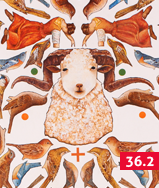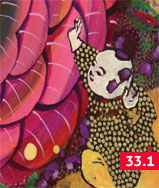The Journal was edited from 1985 to1990 by poet David Citino and was then co-edited for many years by novelist and essayist Michelle Herman and poet Kathy Fagan. In recent years it has become a student-run publication with editorial positions changing hands annually.
Alex Fabrizio took over as managing editor of The Journal in June 2012. She previously served as its production manager and reader of unsolicited submissions. Her poetry has appeared in the Los Angeles Review, Subtropics, West Branch, Birmingham Poetry Review and elsewhere.
Ms. Fabrizio recently took time out of her busy schedule to converse with TCR
TCR Chats with The Journal editor Alex Fabrizio
 |
| Alex Fabrizio |
A: The Journal has changed a great deal over the past two years: we’ve moved to online-only submissions, created a beautiful new website, changed our publication schedule to quarterly (with two print and two online issues), plus started including major art features in all of our issues. We’ve had editors over the past two years with enormous vision; my goal has been to standardize our policies, get our finances in order, and make sure that The Journal can continue to perform at the highest level possible for years to come.
Q: How many submissions does The Journal receive in a typical month?
A: It’s hard to say exactly, since poetry packets usually contain three to six submissions, but all told we receive about six hundred submissions on average each month.
 |
| The Journal, Autumn 2011 |
A: I’d say that we generally receive more, and better, submissions. It’s also allowed us to manage submissions more efficiently and stay in closer contact with submitters; all-in-all, it’s been an entirely positive change.
Q: What happens when a manuscript is received?
A: Manuscripts are first screened by our excellent staff of readers. After that, they pass all of the submissions to the associate genre editors, who make initial rejections. The associate editors pass along their top choices to the genre editors, who make all final decisions on acceptance. This elaborate process is overseen by our assistant managing editor.
Q: What is (roughly) the fiction, poetry, non-fiction breakdown of the submissions that come in?
A: About half poetry and half fiction, with just a tiny trickle of nonfiction. We would love more nonfiction submissions!
Q: What are some common reasons a manuscript is rejected?
A: All sorts of reasons, really. It doesn’t match our aesthetic, it’s too long to justify the page count it would take up, the writing/characterization/level of language, etc, etc, just isn’t up to the standard of quality we’re looking for… It could be anything. We try to send personal notes to submitters with particularly strong manuscripts to encourage them to continue to submit. We’ll also, in very special circumstances, work with an author about editing a piece we feel is very close.
 |
| The Journal, Spring 2012 |
A: The print run of our issues is currently at 1,200, though our online issues, of course, are likely read much more widely.
Q: Who reads The Journal?
A: We've got really great readers who are always interacting with us on our blog, Facebook, Twitter, etc—plus submitting their work. Nothing's better than submissions from our readers. Just thinking about my interactions with subscribers and fans of The J via email, social media, and of course in person at readings and at AWP, I know that they're smart, sophisticated, voracious readers who are as eager as we are to find the most exciting and bold literary writing being done today.
Q: How do you keep The Journal from being an academic journal read only by people in the "field" of creative writing?
A: Well—we don’t, really. We are an academic journal, run by a staff of graduate students out of a university English department, and we’re proud to represent possibly the most ambitious MFA journal around. With that said, I think that our very active online presence helps us extend our reach to all writers, not just those associated with academic programs.
 |
| The Journal, Summer 2012 |
A: As I mentioned earlier, due to our all-graduate-student staff, The Journal is constantly evolving. The genre and managing editors change annually or bi-annually, so we're always accepting slightly different work. The changing staff also means that new ideas get implemented regularly and rapidly; each new editor leaves his or her mark on the magazine and its processes. We're also particularly proud of the dual online/print nature of the magazine, which allows us to choose the best format for each piece we publish. That means we can publish elaborate art features in a variety of media, audio recordings of selected writers, a wide range of interviews and reviews of new books, and more.
Q: Would you agree that contemporary readers are more interested in non-fiction than in fiction?
A: I’m not sure it’s as dramatic as that, though I do think that nonfiction is rapidly growing both in commercial and literary publishing. I’m proud that we publish all three, and I’d be even happier if more people started sending us their nonfiction!
Q: The Journal is a quarterly with print issues appearing in Winter and Summer and online issues appearing in Spring and Autumn. Will this schedule change in the near future?
A: I sure hope not. It’s taken us the better part of two years to perfect the system, so I don’t think it’s going anywhere in the near future! I think we’ve really embraced contemporary technology with our two online issues, which allow us to publish more and varied content.
 |
| The Journal, Spring/Summer 2009 |
A: Yes, our forty-year anniversary is coming up in 2013! We’re excited about that and talking now about how to mark the occasion. The Journal has changed a lot, I think. Two years ago we lost all department funding including the funding that paid our editors' (very small) salaries. We had to dramatically re-envision how we wanted the magazine to function. Former editors Kathy Fagan and Michelle Herman decided to turn the magazine over entirely to volunteer graduate students. Because none of the graduate students were getting paid, we decided to split up the work of The Journal into as many staff positions as possible, which caused us to essentially quadruple our staff. Losing our major source of funding helped us quadruple our staff and double our publication schedule. So it looks like things turned out all right! The English department at Ohio State now furnishes The Journal with office space, tech support, bank account and donation management, and a small printing/copying allotment, all of which we're extremely grateful for. Another change is that we’ve started embracing more fully the intersection between literary and visual art with our fantastic art features each issue. But we’ve retained our commitment to publishing daring and wholly original work from the very best new and established writers.
Q: What is the biggest challenge you face as editor of a literary magazine?
A: We play to our strengths at The J, so the challenges I face are ones I feel comfortable with—getting contributors paid via elaborate department bureaucracy, herding my staff closely enough so that we manage to have staff meetings,figuring out why our main computer is locked to a desk and can’t be removed…The genre editors have the really tough challenges: picking less than ten stories for an entire year! I could never do that.
Here's more information --
Interview About The Journal. LitBridge. August 26, 2012.

Finally I have found what I have been looking for since 2 hours. I really like your blog and articles you are writing for us. Gandhi Quotes in Telugu
ReplyDeletealways support you blog agen togel terpercaya
ReplyDeleteProduction of literary journals is a matter of responsibility. Many professional writers are working on writing editing literary magazines. Professional writers are more professional than those who work for companies like the best essay writing service https://orderessay.net/writing-an-essay-about-yourself.html (that also propose writing essay that has a type "essay about yourself"/"essay about myself")
ReplyDeleteThanks for thiss
ReplyDelete